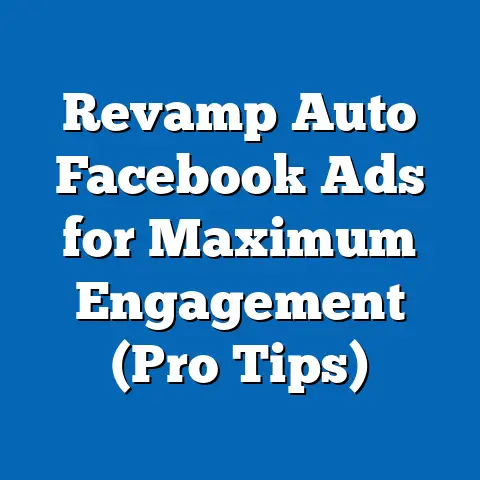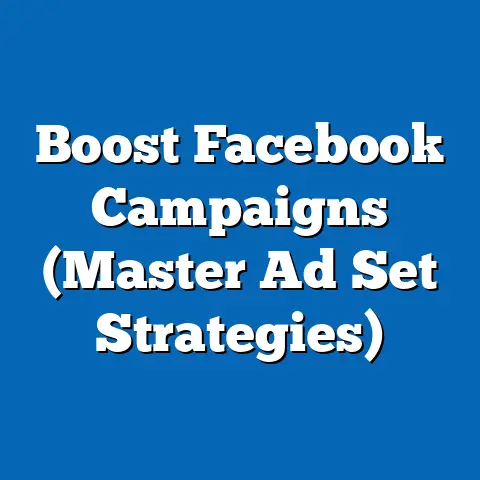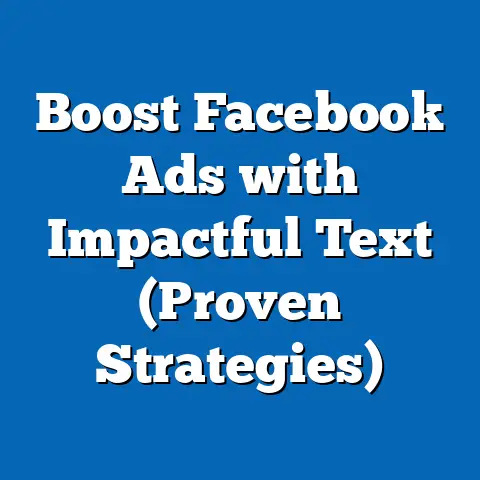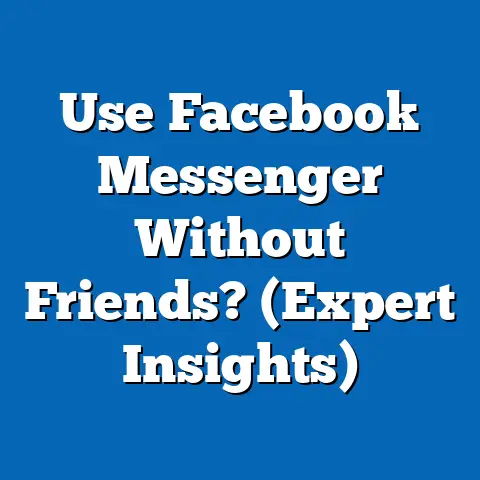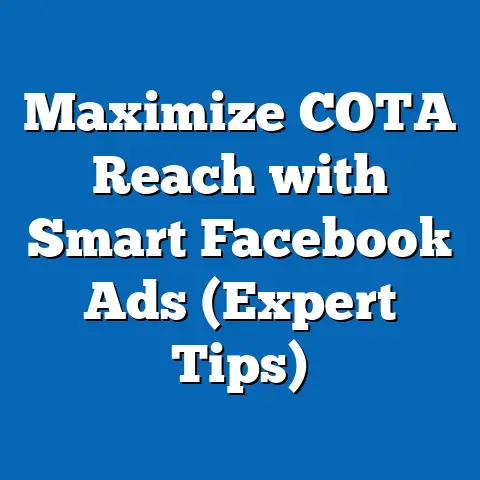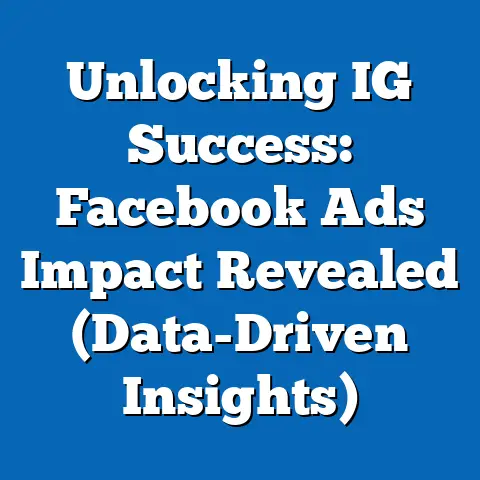Master $20 Facebook Ads (Cost-Effective Strategies Revealed)
“You need a big budget to succeed with Facebook ads.” I’ve heard this countless times, and honestly, it used to be a belief I held myself. We often associate success with massive spending, especially in the advertising world. However, over the years, I’ve discovered that this is a misconception that can prevent many small businesses and entrepreneurs from tapping into the immense potential of Facebook advertising. Today, I’m going to show you how to break free from that mindset and achieve impactful results with a modest $20 budget.
In this article, I’ll guide you through the world of Facebook ads, debunking the myth that success requires deep pockets. You’ll learn how to leverage strategic targeting, compelling content, and smart optimization to make the most of your $20 investment. Get ready to unlock the power of cost-effective Facebook advertising!
Understanding the Facebook Ads Ecosystem
Before diving into the specifics of running a $20 ad campaign, let’s first understand the Facebook Ads ecosystem. Facebook’s advertising platform operates on an auction system. Advertisers bid for ad space, targeting specific audiences based on demographics, interests, behaviors, and more. The ads that are deemed most relevant and valuable to users win the auction and are displayed in their feeds.
One of the greatest advantages of Facebook ads for small businesses and entrepreneurs is the unparalleled access to a vast audience. With billions of active users, Facebook offers a massive pool of potential customers. Moreover, the platform provides sophisticated targeting capabilities, allowing you to reach specific segments of the population who are most likely to be interested in your products or services.
However, remember that understanding your audience is paramount. Before launching any ad campaign, you need to know who you’re trying to reach, what their interests are, and what motivates them. This knowledge will guide your targeting strategy and inform the creation of compelling ad content.
Takeaway: Facebook ads offer immense potential for businesses of all sizes, but a deep understanding of the platform and your audience is crucial for success.
Debunking the Misconception
The misconception that you need a large budget to succeed on Facebook stems from several factors. Statistics often cite the average cost per click (CPC) and conversion rates, which can seem daunting. According to recent data, the average CPC on Facebook can range from $0.50 to $2.00, depending on the industry and targeting. This can lead some to believe that a small budget won’t yield any meaningful results.
However, I’ve seen firsthand how creativity and strategy can often outshine budget size. I remember working with a local bakery that had a very limited advertising budget. Instead of throwing money at broad, generic campaigns, we focused on hyper-targeting a small, highly engaged audience within a 5-mile radius of the bakery. We created visually appealing ads showcasing their daily specials and ran them during peak hours. The result? A significant increase in foot traffic and a noticeable boost in sales, all achieved with a daily budget of just $15.
This is just one example of how a well-thought-out strategy can overcome budget constraints. It’s not about how much you spend, but how strategically you invest your resources.
Takeaway: Don’t let the perceived need for a large budget deter you from exploring the potential of Facebook ads. With the right approach, even a small investment can yield impressive results.
Cost-Effective Strategies for $20 Facebook Ads
Now, let’s delve into the specific strategies you can use to make the most of your $20 Facebook ad budget.
A. Targeting the Right Audience
Audience segmentation is the cornerstone of any successful Facebook ad campaign, especially when working with a limited budget. You can’t afford to waste your precious ad spend on reaching people who are unlikely to be interested in your products or services.
Facebook’s Audience Insights tool is your best friend here. It allows you to gain valuable insights into your target audience, including their demographics, interests, behaviors, and more. Use this tool to identify the most relevant segments for your ads.
Here’s how I approach audience targeting:
- Define Your Ideal Customer: Start by creating a detailed profile of your ideal customer. Consider their age, gender, location, interests, income level, and any other relevant characteristics.
- Use Facebook’s Audience Insights: Input your ideal customer’s characteristics into the Audience Insights tool to discover potential audience segments.
- Create Custom Audiences: Upload your existing customer list to create a custom audience of people who have already interacted with your business.
- Build Lookalike Audiences: Leverage Facebook’s lookalike audience feature to find new people who share similar characteristics with your existing customers.
By focusing on highly targeted audiences, you can significantly improve your ad relevance and conversion rates, making your $20 budget go further.
Takeaway: Precision targeting is key to maximizing the impact of your limited ad budget. Use Facebook’s Audience Insights tool and custom/lookalike audiences to reach the most relevant people.
B. Crafting Compelling Ad Copy and Visuals
In the crowded landscape of social media, your ad needs to stand out to grab attention. This is where compelling ad copy and high-quality visuals come into play.
Here are some tips for creating attention-grabbing ads:
- Write Attention-Grabbing Headlines: Your headline is the first thing people see, so make it count. Use strong verbs, intriguing questions, or compelling offers to pique their interest.
- Craft Persuasive Ad Copy: Highlight the benefits of your product or service and explain how it solves a problem for your target audience. Use clear, concise language and avoid jargon.
- Use High-Quality Visuals: Invest in professional-looking images or videos that showcase your product or service in the best possible light. Even better, use user-generated content to appear more authentic.
- Keep it Short and Sweet: People have short attention spans, so get to the point quickly. Use bullet points or short paragraphs to make your ad easy to read.
Remember, you don’t need to break the bank to create eye-catching visuals. There are numerous free or low-cost tools available, such as Canva, that allow you to design professional-looking graphics and videos.
Takeaway: Compelling ad copy and high-quality visuals are essential for capturing attention and driving engagement, even on a small budget.
C. Choosing the Right Ad Format
Facebook offers a variety of ad formats, each with its own strengths and weaknesses. When working with a $20 budget, it’s important to choose the format that’s most likely to deliver the best results for your specific goals.
Here’s a breakdown of some popular ad formats and their suitability for low-budget campaigns:
- Image Ads: These are the simplest and most straightforward ad format. They’re ideal for showcasing a single product or service with a visually appealing image and concise copy.
- Video Ads: Video ads are highly engaging and can be effective for telling a story or demonstrating a product in action. However, they can be more expensive to produce than image ads.
- Carousel Ads: Carousel ads allow you to showcase multiple images or videos in a single ad unit. They’re great for highlighting different features of a product or service or telling a sequential story.
- Slideshow Ads: Slideshow ads are a cost-effective alternative to video ads. They allow you to create a short video-like experience using a series of still images.
For low-budget campaigns, I often recommend starting with image ads or slideshow ads, as they’re relatively easy and inexpensive to create. Once you’ve gathered some data and insights, you can experiment with other formats.
Takeaway: Choose the ad format that best aligns with your goals and budget. Image ads and slideshow ads are often a good starting point for low-budget campaigns.
D. Optimizing Ad Spend
Even with the most targeted audience and compelling ad content, your campaign won’t succeed if you don’t optimize your ad spend effectively.
Here are some tips for maximizing your ROI:
- Choose the Right Bidding Strategy: Facebook offers several bidding strategies, including cost per click (CPC) and cost per mille (CPM). CPC bidding is generally recommended for low-budget campaigns, as you only pay when someone clicks on your ad.
- Set a Daily Budget: Determine how much you’re willing to spend per day and set a daily budget accordingly.
- Monitor Ad Performance: Keep a close eye on your ad performance metrics, such as impressions, clicks, click-through rate (CTR), and conversions.
- Adjust Campaigns in Real-Time: If you notice that certain ads or audience segments are underperforming, adjust your campaigns accordingly. This might involve changing your targeting, ad copy, or bidding strategy.
One of the most valuable lessons I’ve learned is the importance of continuous testing and optimization. Don’t be afraid to experiment with different variations of your ads to see what works best.
Takeaway: Continuous monitoring, testing, and optimization are crucial for maximizing your ROI and making the most of your limited ad budget.
Real-World Examples of Successful $20 Campaigns
To illustrate the power of cost-effective Facebook advertising, let’s look at a few real-world examples of businesses that have successfully executed $20 campaigns.
Case Study 1: Local Bookstore
- Objective: Increase foot traffic to the store.
- Strategy: Targeted ads to people within a 10-mile radius who were interested in books, reading, and local events. Ads featured images of new arrivals and highlighted upcoming author events.
- Results: A 20% increase in foot traffic on weekends and a noticeable boost in book sales.
- Lessons Learned: Hyper-local targeting and event-based promotions can be highly effective for brick-and-mortar businesses.
Case Study 2: Online Clothing Boutique
- Objective: Drive traffic to their website and increase online sales.
- Strategy: Carousel ads showcasing different outfits and accessories. Targeted ads to women aged 18-35 who were interested in fashion, online shopping, and specific clothing styles.
- Results: A 15% increase in website traffic and a 10% increase in online sales.
- Lessons Learned: Visually appealing carousel ads and targeted demographics can drive significant results for e-commerce businesses.
Case Study 3: Freelance Graphic Designer
- Objective: Generate leads and acquire new clients.
- Strategy: Video ads showcasing their portfolio and testimonials from satisfied clients. Targeted ads to small business owners and entrepreneurs who were interested in graphic design, branding, and marketing.
- Results: A steady stream of leads and a few new clients.
- Lessons Learned: Video testimonials and targeted messaging can be highly effective for service-based businesses.
These case studies demonstrate that with a well-defined strategy and targeted execution, even a small budget can yield meaningful results.
Takeaway: Real-world examples provide inspiration and validation for the effectiveness of low-budget Facebook ad campaigns.
Conclusion
As we’ve explored in this article, effective Facebook advertising doesn’t require a hefty budget. By understanding the Facebook Ads ecosystem, debunking the misconception about needing a large budget, and implementing cost-effective strategies, you can achieve impressive results with a modest $20 investment.
I encourage you to experiment with your own $20 Facebook ad campaigns. Remember, the key is to start small, test different approaches, and continuously optimize your campaigns based on the data you gather. With a little creativity and strategic thinking, you can unlock the power of cost-effective Facebook advertising and drive meaningful results for your business.
So, go ahead, challenge the status quo, and prove that success doesn’t always require deep pockets. Your $20 Facebook ad campaign could be the start of something big!

